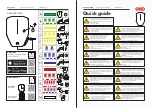
Cooling System
The engine in your Honda contains a number of aluminum parts.
Therefore, it requires an antifreeze/coolant specifically formulated
to protect the aluminum parts from corrosion. Failure to use a
suitable antifreeze/coolant may seriously shorten the life of the
engine as the result of rapid corrosion damage. Some antifreeze/
coolants, although labeled for use in engines containing aluminum,
may not provide adequate protection for your engine.
Therefore, use only a Honda
RECOMMENDED
antifreeze/coolant.
CHECK WITH YOUR AUTHORIZED HONDA DEALER.
For best corrosion protection, the mixture of coolant and water
must be maintained year-round at 50/50. Concentrations less than
50% coolant may not provide sufficient protection against
corrosion and freezing. Concentrations of greater than 60% coolant
will impair cooling efficiency and are not recommended. Low-
mineral drinking water or distilled water should be mixed with the
antifreeze/coolant. Coolant loss should be replenished by a mixture
containing the proper concentration of antifreeze and water.
Do not mix different antifreeze/coolants.
Do not use additional rust inhibitors or anti-rust products, as they
may not be compatible with the radiator coolant.
ENGINE DAMAGE CAUSED BY IMPROPER COOLANT USAGE IS
NOT COVERED BY THE NEW CAR WARRANTY.
Checking Coolant
Check the coolant level in the reserve tank when the engine is at
normal operating temperature (with the engine off and the car on
the level ground), using the dipstick in the reserve tank. Remove the
dipstick and wipe it off. Insert the dipstick and remove it. The
coolant level should be between the MAX and MIN marks.
Do not remove the radiator cap when the engine is hot; the
coolant is under pressure and could severely scald you.
Keep hands away from the radiator fan. The fan may start
automatically without warning and run for up to 15 minutes,
even after the engine is turned off.
Main Menu
▲
▼
Summary of Contents for 1991 Prelude
Page 84: ......
Page 131: ...Specifications cont d ...
















































